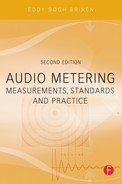Chapter | eleven
Characteristics of Level Meters
CHAPTER OUTLINE
Distortion Introduced by the Peak Program Level Meter
The characteristics of individual instruments are normally defined and set in international standards. Some of the most important standards are IEC 60268-10, IEC 60268-17 and IEC 60268-18. In addition, recommendations may be provided by the ITU or the EBU. Alternatively, there can be national standards which apply, such as ANSI or “Technische Pflichtenhefte der öffentlich-rechtlichen Rundfunkanstalten in der Bundesrepublik Deutschland” (Publication of technical requirements for public broadcasters in Germany).
DEFINITIONS AND REQUIREMENTS
In this chapter a number of general definitions and specifications will be reviewed together with examples of related specifications. The specifications here all refer to the IEC standards.
Reference Indication
Analog instruments The instrument must have a marking on its scale that shows the maximum level allowed in the system to which the instrument has been connected. This marking can be expressed in percent (for example 100%), dB (for example 0 dB), or Volume Units (for example 0 VU). This does not necessarily involve an absolute level.
Digital instruments The reference indication corresponds to full scale. The indication is normally marked 0 in terms of dB.
Reference Input Voltage
Analog instruments This is the reference signal necessary to reach reference indication and is described by the RMS value of a 1000 Hz sinusoidal signal.
IEC Type I: If nothing else is specified, the voltage is 1.55 V. It can also be expressed in dB relative to 0.775 V. For example, +6 dB re 0.775 V or +6 dBu.
Volume indicators, VU (as per IEC 60268-17): The applied voltage for reaching the reference position is 1.288 V.
Division of The Scale
Analog instruments This is the graphical display of the signal concerned.
IEC Type I: −40 dB − +3 dB (minimum).
IEC volume indicator: −20 − +3 VU
Digital instruments The graphical display can either be an incremental dot or bar graph. Numerical values may indicate headroom or a reference if the input is analog.
Scale markings:
0 dB to -20 dB numbers per 5 dB and minor tics every 1 dB
-20 dB to -40 dB numbers per 10 dB and no minor tics
-40 dB to -60 dB numbers per 10 dB and a minor tic at -45 dB
Amplitude Frequency Response
This is the difference, expressed in dB, which occurs between the levels indicated for a given frequency and the indication that occurs at a reference frequency, normally 1000 Hz.
Analog instruments IEC PPM: 31.5 Hz - 16 kHz ± 1 dB
Digital instruments IEC digital: 20 Hz - 20 kHz ± 0.5 dB
Dynamic Response
This expresses what the instrument displays for a 5 kHz tone burst of different durations (100, 10, 5, 1.5 ms) in relation to a continuous 5 kHz sinusoidal tone (or >10 kHz for very short responses like 0.5 ms). The requirements are expressed by a curve or in a table.
Delay Time
Analog instrumentsD The time it takes from when a reference voltage is applied until the display reaches 1 dB under the reference value.
IEC PPM: Less than 300 ms
Digital instrumentsD Delay time is the time interval between the application of the reference input signal and the moment when the indicator passes a point 1 dB below reference indication. This delay is normally related to processing time.
IEC digital: Less than 150 ms
Integration Time
This is the duration of a tone burst at a reference level that brings the indication to a given point under the reference value.
Analog volume indicator 300 ms to reach 99% of the reference value
Analog and digital PPM instruments 5 ms results in an indication 2 dB below the reference value
Overswing
This represents the maximum indication above a reference value that occurs when a 1000 Hz signal is applied to the instrument at the reference level.
Analog and digital instruments ≤ 1 dB
Return Time
Analog and digital instruments The time it takes for the indication to fall to a defined point below the reference value when an applied constant signal at the reference level is removed.
IEC PPM and digital: 1.7 s ± 0.3 s / 20 dB
Reversibility Error
Analog instruments The difference in the indication when an applied asymmetric signal is phase-inverted.
IEC Type I: ≤1 dB
Input Impedance
This is the internal impedance of the instrument in its entire active frequency range.
Analog, PPM: >10 kΩ
Analog, volume indicator: 7.5 kΩ
Distortion Introduced by the Peak Program Level Meter
This represents the total harmonic distortion that is caused by the presence of the instrument.
IEC Type I: <0.1%
Overload Characteristic
The expresses the maximum input signal (sinusoid) that the instrument can handle without it subsequently altering the specifications of the instrument.
IEC Type I: >20 dB for a 5 second signal
>10 dB for a continuous signal
Supply Voltage Range
Analog and digital instruments The maximum allowable variation in supply voltage for a given deviation in the indication.
The chapters which follow will describe the relevant instruments in more detail.
